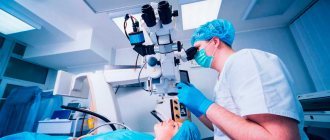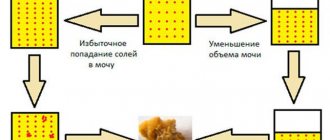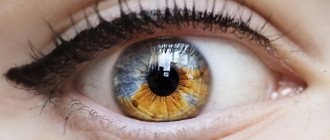Hypertonicity in a newborn: main signs
It is necessary to constantly monitor the behavior of the baby in order to detect violations and correct them in a timely manner. Parents should monitor their baby and contact a specialist if they detect the following characteristic signs:
· From 1-2 days after birth, the baby already holds his head, and does not lower it. · Cyclic regurgitation after eating, general loss of appetite, intestinal pain. · Heavy short sleep, during which tension persists: arms and legs are pressed tightly to the chest, the head is pulled back, and sometimes nervous spasms are observed. · The head throws back, the chin and arms shake convulsively while crying. · Very high excitability of the baby, he reacts painfully even to faint sounds and light, which act as irritants on him.
However, treatment of disorders is often started without in-depth diagnosis. Often, increased muscle tone is not an independent disorder, but a symptom of other diseases - cerebral palsy, congenital malformations of the brain, spinal injuries and hereditary pathologies.
In such cases, in addition to these signs, the child may have other neurological symptoms. Then treatment of the underlying disease will be required.
Hypertonicity can be detected by simply taking the baby by the arms and placing him on a flat surface. If a baby at 1-2 months begins to reflexively step and plant his foot completely, rather than walk on tiptoe, this may indicate increased tone.
It is important for parents to pay attention to whether the baby passes the main stages of development on time. By one month, the baby begins to briefly raise his head; at 2-3 months, he begins to hold it vertically for 5 minutes or more. One should be alarmed by the appearance of this skill either too late or too early. If a baby, already a month old, lies on his stomach for a long time with his head raised, this may indicate increased tone. You should definitely visit a doctor.
At 3 months, the baby already begins to roll over onto his side, and a full, correct turn is possible at 6 months; up to this point, if the baby turns, he does so through extension of the head. If a child masters flips only through the right or left side, parents should be wary. At the same age, the physiological tone of the flexor muscles naturally decreases. At first it decreases in the arms, and then in the legs. However, this condition is normal: in the absence of other complaints, the baby’s development occurs in accordance with age norms.
An important diagnostic criterion for hypertonicity in infants is tremor of the baby’s chin and/or limbs. Involuntary trembling should not be immediately alarming; it can be considered normal before the age of 4 months - for example, during crying, prolonged fussing, feeding or temperature changes. In such cases, the tremor is very short-lived and passes quickly. However, if the trembling occurs spontaneously and at rest, intensifies during crying and lasts for a long time, this may be a sign of hypertonicity, increased intracranial pressure or high convulsive readiness. In such conditions, the baby must be examined by a neurologist and, if necessary, prescribe additional examinations.
There are 3 types of hypertonicity: · Dystonic. This is a combined type that combines the symptoms of hyper- and hypotonicity. With this type of pathological condition, some muscle groups become overly tense, while others become very relaxed. Arms and legs with hypotonicity are usually relaxed, while those with hypertonicity are tightened. Dystonia can affect all muscles. · Symmetrical. This type of disorder is manifested by clenching of fists or fingers on both extremities. The pathology can cover the entire muscular system or be localized in the arms or legs. · Asymmetrical. There is severe tension on one side with normal symptoms on the other. The baby has characteristic clinical signs: he turns over on his side and squirms. The head is almost constantly turned to the side with increased muscle tone, which signals hypertonicity of the neck muscles. If only one leg bends in a supine position, this indicates high tone of the other leg. If there is asymmetrical hypertonicity, it turns the body towards the side with excess tone, and the torso will bend in an arc. Only symmetrical tone is a physiological norm; all other conditions are considered pathologies.
Tremor in infants
Tremors in newborns are muscle spasms that appear in newborns from the very moment of birth. As a rule, tremor in newborns manifests itself in the form of cramps of the upper and lower extremities and chin. Sometimes a head tremor is observed, but such a manifestation indicates complex problems of a neuralgic nature. Meanwhile, tremor in a newborn, when spasms affect the arms, legs and chin, is not considered a pathology.
Tremor in newborns develops due to the underdevelopment of the centers of nerve endings that are responsible for all body movements in the brain. In addition, the appearance of tremor in newborns is influenced by too high a concentration of norepinephrine in the blood serum, which makes itself felt when the child is emotional. A large amount of this substance occurs again due to the unpreparedness of the upper layer of the adrenal glands for extrauterine life.
As a rule, mothers for whom the newborn is not the first child notice a similar condition in the maternity hospital and do not pay too much attention to it. For young, inexperienced mothers, tremor in a child can cause considerable fear and even panic.
Especially if a similar condition has arisen in a baby for the first time and there is no one to ask what it is and what to do.
Tremors in newborns can appear at any time, but most often during screaming, crying, when changing clothes, bathing, whenever the baby experiences discomfort. Trembling of the chin and hands, in most cases, is a physiological process and is associated primarily with the immaturity of the nervous system, even in a full-term baby.
Direct contraction of smooth muscle is caused by norepinephrine produced by the adrenal glands. In an adult, the content of norepinephrine in the blood is, as a rule, in an amount that does not cause discomfort, and in stressful situations, the nervous system responds promptly and correctly to the increased level of the hormone.
For a baby in the first months of life, everything turns out differently. The immaturity of the adrenal medulla, the nerve centers responsible for the motor function of the body, provokes tremors in newborns with physical and emotional discomfort.
Often, tremor in newborns appears as a consequence of prematurity, rapid or protracted labor, uterine hypertonicity, fetal hypoxia during pregnancy, that is, all pathological conditions during pregnancy and childbirth.
Tremors occur especially often in children born much earlier than expected. The initially immature nervous system is not able to respond correctly to changes in the external environment, so even ideal care for a premature baby cannot avoid such a symptom.
In medicine, there is a unique critical time for the extrauterine development of a newborn, in particular its nervous system, when the nerves are the most sensitive, and, accordingly, even the slightest deviation can cause serious disorders. Critical time is the first and third, ninth and twelfth months of the newborn’s existence outside the mother’s womb. It is at this time that it is necessary to be extremely attentive to the child’s condition and, if there is the slightest problem, contact a neurologist.
Causes of hypertension
The development of hypertonicity is possible due to exposure to adverse factors during pregnancy, childbirth, or in the first weeks after them. During the prenatal period, the baby can be harmed by:
· prolonged hypoxia – insufficient oxygen supply; · acute infectious diseases suffered by a pregnant mother; · maternal abuse of alcohol, alcoholic beverages, drugs; · uterine tone, toxicosis and threat of miscarriage; · hemolytic disease of the baby caused by Rh conflict between mother and fetus; · perinatal encephalopathy; · genetic disorders; · pathologies of development of the brain or spinal cord.
Unfavorable environmental conditions, frequent stressful situations, infections, increased intracranial pressure, and injuries in the postnatal period can lead to pathological disorders. The cause of hypertonicity is often difficult, rapid or too long labor, as well as entanglement of the fetus with the umbilical cord. Birth injuries can disrupt the functioning of the central nervous system of infants and cause various disorders.
The baby's head is slightly larger than the diameter of the mother's birth canal, and since some parts of the skull bones are soft, it can change. Any obstacle or delay causes mechanical damage to the skull, which leads to impaired blood circulation in the brain structures and hypoxia. Intracranial pressure may also increase.
Hypertonicity is caused not only by birth, but also by physical trauma in later life. Any traumatic impact can cause a myotatic reflex - it leads to an increase in muscle tone to protect against potential damage (this is the body's natural defense mechanism). Thus, in whiplash injuries of the cervical spine, the neck muscles contract in order to immobilize the spine. The same reactions are possible with the muscles of the thoracic or lumbar region.
In the acute period of injury, the presence of hypertonicity is the norm, since it prevents re-injury of the vertebrae, discs, and ligaments.
Increased tone can also occur during stress. Even a quiet, sharp cry or fright of a baby often leads to hypertonicity of the following muscles: · occipital; · upper trapezoid; · diamond-shaped; · calf; · square lumbar.
Hypertonicity often causes pain in compressed blood vessels, as well as lymphatic and capillary congestion. After all, this is where metabolites—products of cellular metabolism—accumulate.
Features of massage for tics in children
When getting rid of hyperkinesis, the following types of procedures are used:
General. The essence of the manipulation is to relax various parts of the child’s body. The massage therapist performs gentle rubbing, kneading, and stroking. Active, rough influences are not allowed. Manipulations should be relaxing and calming.- Neck and neck massage. Helps significantly improve blood circulation in the brain, having a beneficial effect on the entire nervous system of the baby.
- Massage for facial tics. Relaxes the child's muscles by pressing and scrolling 3 times clockwise to the following points: on the lower eyelid under the pupil, at the level of the mouth under the center of the eye, a centimeter from the edge of the face from the side of the lower jaw.
- Underwater shower-massage. Perfectly relieves muscle tension.
Courses usually consist of 10 sessions, which must be completed in full, even if the condition has improved after several of them.
Why is hypertension dangerous?
Hypertonicity can be caused by disorders of the central nervous system. Without adequate treatment, such deviations worsen and develop over time: at first, infants experience disturbances in motor activity, then problems with fine and gross motor skills, coordination of movements, and speech functions appear. Possible disturbances in gait and posture, developmental delays. All this indicates that increasing the physiological tone of infants requires special control from parents. Timely detection of disorders and their etiological factors, as well as subsequent correct therapy, are the key to good health and normal development of the baby.
Pathologically high muscle tone interferes with the harmonious development of the child, delays the rate of motor development (the baby begins to roll over, walk, and sit late). The formation of the musculoskeletal system is disrupted, which in the future spoils gait and causes other pathological changes. Hypertonicity can also indicate the presence of serious neurological pathologies, which are very important to detect and eliminate in the early stages.
Treatment of increased physiological tone of the baby
Hypertonicity is a fairly common disorder in children, but an experienced pediatrician and pediatric neurologist can easily detect it. Sometimes the increase in physiological tone goes away on its own within 4-5 months. In addition to the main symptoms, experts study the following reflexes of the baby (in the case of normal development, they themselves disappear by the specified age):
· Step reflex. In an upright position, the child begins to walk on level surfaces. · Support. The baby places his foot on the entire foot, and not on his toes. · Symmetry/asymmetry reflex. In the supine position, with the chin pressed to the chest, the baby's legs extend and arms bend. When the head tilts to the right, the left limbs bend, and the right limbs bend to the left. · Tonic. In the position on the stomach, the arms and legs are bent, and in the position on the back - straightened.
The pediatrician often prescribes a set of procedures for children with increased physiological tone that only eliminate the main symptoms, but he does not find the true causes of the disorder and does not solve the problem. Neither drug treatment, nor aromatherapy, nor physiotherapeutic procedures as monotherapy affect the causes of pathology, therefore osteopathic treatment is considered the most effective treatment. Osteopaths view the body as a single whole, in which all organs and systems are interconnected. They can treat one system while working with another, revealing the cause of pathological changes. The osteopath's fingers are very sensitive and receptive, and the manipulations are extremely soft and careful. Therefore, osteopathic treatment is safe, painless and effective for hypertonicity. The specialist will ensure normal and full functioning of the child’s not fully formed nervous system.
When drawing up a therapy program, the doctor will compare the neurological symptoms with the overall development of the baby and, if necessary, prescribe additional examinations. Observing the child in dynamics, comparing the tone with his skills and abilities will allow you to make a final medical conclusion.
Treatment methods
The treatment method for tremor of the arms, legs, and head in a child is aimed at restoring the health of the baby in general and the nervous system in particular.
The recommendations of a pediatric neurologist should be strictly followed.
Massage for tremors in infants
In addition, parents definitely need to create a pleasant, cozy and friendly environment around their baby, systematically massage their baby (it promotes relaxation), instill swimming skills (this is possible even in a home bath), and do therapeutic exercises with him.
Such efforts of parents will not be in vain.
The easiest way to master massage techniques for newborns (from the age of 5-6 weeks) at home. The pediatrician will definitely teach mom and dad basic massage movements, based on which you can then proceed to perform a variety of exercises.
The basic massage movements are:
An important role is played by the baby’s psychological mood and his physical comfort during the massage:
- The room needs to be ventilated, this will take 20-30 minutes (if the weather is warm outside, then the massage can be performed with the window open);
- Hands must be dry, bracelets and rings must be removed, nails must be trimmed;
- Before starting the massage, you should shake your hands and rub your palms together so that they become warm;
- The massage session is carried out during the baby’s active waking hours; it is always necessary to ensure that he is in a good mood. If the mood deteriorates, you need to stop for a while, cheer up the child and you can continue;
- The place where the massage is performed should be familiar to the baby; it is convenient to do it on the changing table;
- Nothing should disturb the child, for example, the sun shining in his eyes;
- When doing a massage, it is useful to talk with the baby, smile, sing songs, it is better if the facial expressions are emotionally rich;
- Massage is always accompanied by stroking;
- There is no need to use aromatic oils or powder so as not to clog delicate pores (it is better to use regular products used for daily moisturizing for massage purposes);
- The highest effect of massage is observed before water procedures;
- Movements should be smooth. The massage begins with the face: in this case, it is necessary to stroke the baby along the edges and along the wings of the nose.
Features of osteopathic correction
A decrease in blood flow is usually caused by mechanical factors. A child’s brain grows and develops very quickly; at such a pace, it is important to eliminate hypertonicity at the earliest stages. This is also due to the fact that the younger the baby, the softer its bones, and the easier it is to deal with mechanical factors. Doctors at the Quality of Life clinic successfully eliminate the problem, which creates conditions for the normal growth and development of the child in accordance with age standards.
Osteopathy considers increased physiological tone as a disruption of the spinal cord and brain. This leads to the fact that the muscles receive excessive stimulation, resulting in their hyperfunction. Hypertonicity can affect both individual muscle groups and the entire musculature of the body, which is observed with cerebral palsy.
Osteopathic treatment in our clinic is aimed at: · balancing the bones of the skull; · elimination of stress from the hard shell and hemispheres; · relieving muscle tension; · ensuring the full functioning of the nervous system. This allows you to completely normalize the baby’s physiological tone.
The first year of a child’s life is the most effective for the treatment of neurological disorders, including hypertonicity, so therapy should be started as early as possible. However, our osteopaths will eliminate increased tone even in case of late treatment.
Osteopathic correction of hypertonicity does not cause pain or discomfort in the newborn, therefore it is absolutely safe. The positive effect will be noticeable after 1-2 sessions; the baby will improve not only muscle tone, but also appetite, sleep, and digestive processes will be normalized. An experienced osteopath triggers important self-regulation mechanisms of the body, which correct the functioning of brain centers and metabolic processes between them.
We offer: · Individual treatment programs. When developing a strategy, the physical characteristics of not only the child, but also the mother are taken into account. The nature of pregnancy, difficulties during pregnancy, the presence of concomitant disorders, and general health are taken into account. · Supervision after therapy. The treating specialist is always in touch, monitors the results of the therapy, and provides recommendations for maintaining health with hypertension.
After the therapy, we develop individual sets of exercises for independent training with a child with hypertonicity, if there is such a need.
When drawing up a treatment program, the doctor will compare the neurological symptoms with the overall development of the baby and, if necessary, prescribe additional examinations. Observing the child in dynamics, comparing the tone with his skills and abilities will allow you to make a final medical conclusion.
The baby's body is a perfect system that strives to be healthy. The osteopath’s task is to activate and direct self-regulation processes so that the baby can independently maintain balance, and parents can follow medical recommendations. The osteopathic correction methods used in our clinic create a synergistic effect that provides excellent results in eliminating increased tone in children of any age. Our task is not to prescribe a child the maximum number of procedures, but to offer, from a wide range of osteopathic medicine options, exactly those that he really needs. We treat, not heal, we do it safely, effectively and comfortably.
In addition to osteopathic treatment, other techniques are also used in complex therapy. Thus, water is an ideal environment in which muscles and ligaments completely relax. Therefore, as early as 1 month, newborns can be bathed in a large bathtub.
You can teach him to float on his back and on his stomach in the bath. When your child gets older, you can start visiting the pool with him. Herbal baths are also extremely useful.
To do this, you can use special mixtures for children or decoctions of sage, motherwort, lingonberry, and valerian root. The bath should be warm, different decoctions can be alternated with one-day breaks.









